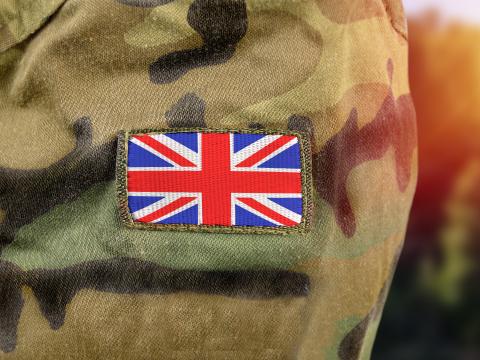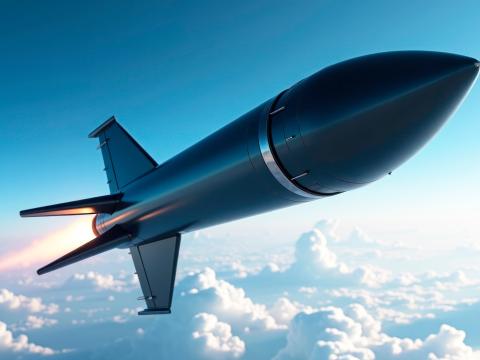Tactical Network Versatility Keeps Warfighter in Touch
Radio architecture provides enhanced functionality.
The U.S. Army is testing a new technology that will enable a seamless connection between the wireless world and the landline world by means of tactical radio networking. Through the use of an already proven network infrastructure, the addition of a centralized routing capability within a family of current-generation tactical field radios has provided access to multiple forms of connectivity that were previously unattainable in the field.
By integrating various telecommunications capabilities within a single radio framework, Harris Corporation, Rochester, New York, has maximized network connectivity to meet emerging communications needs. Scheduled to be released on the market in December, the RF-6010 access hub for the company’s Falcon II family of networked tactical radios enables an uninterrupted flow of information to be transmitted concurrently over both landline- and network-based pathways without losing content or clarity. Functional compatibility with either Ethernet local and wide area networks or satellite networks allows the system to act as a bridge to complete the data paths on as many as four tactical networks.
“The RF-6010 tactical access hub gives us a way of tying into a network infrastructure without requiring a lot of network reconfiguration,” Jeffrey Kroon, senior scientist for tactical networking products, Harris Corporation, states. “By organizing the radio end of the networking process, we simply point our router at the components of a given area network that are required for connectivity so that we can achieve an unimpeded stream of data without having to modify the network itself.”
Developed by Harris’ radio frequency communications division, the Falcon II line of tactical field radios was created for secure ground-to-ground, ground-to-air and satellite communications. Each manpack terminal features multiband high frequency (HF), very high frequency (VHF) and ultrahigh frequency (UHF) capabilities and is powered by a central PowerPC microprocessor. The radios are equipped with Internet protocol (IP) stacks so that existing local and wide area networks (LANs and WANs) can extend seamlessly to the tactical combat radio network. The addition of the RF-6010 network access hub allows each radio to interface directly with other data and telecommunications networks.
Falcon IIs have an advanced HF and VHF subnetwork functionality for data packet processing to take place within each terminal. Packets are grouped according to destination and then compressed and encrypted for transmission over the data network. Access to data channels for the dissemination of collected information is controlled by protocols designed specifically for the frequency of transmissions. IP packet transmissions are optimized by the channel access protocols (CAPs) that prioritize each delivery.
“Depending on channel conditions, the CAPs will regulate the data streams to avoid any collisions during transmission,” Kroon explains. “In situations where many radios are in a given proximity, the rate at which data is transmitted is adjusted accordingly to accommodate the heavy network traffic.” By using a proprietary multiple access with collision avoidance protocol (MACA), real-time changes in channel condition are matched on a transmission-by-transmission basis, he adds. The protocols used for channel access during HF communications differ from those used in VHF line-of-sight transmissions.
The standardization of digital data streams to maximize radio-network compatibility for use in telephony-based communications is also a key company objective within the tactical networking arena. The introduction of voice over Internet protocol (VoIP) offers a way to attach digital voice data to data networks. By employing computer telephony integration technology, radio users can communicate seamlessly with a variety of landline networks in a modular fashion. VoIP, the interface between the tactical radio network and the tactical access hub, lets the company leverage the capability of computer telephony integration to establish reliable transmission pathways from one radio end point to another.
“We can conform simple voice telephony to the acceptable parameters of digital airwave transmission,” Kroon states. The Falcon II radio allows deployed personnel to tune into landline carried signals within the Falcon II network at any time. The radio terminal handset provides a keypad by which users can place calls through the tactical access hub to designated network locations. This variability ensures a higher degree of connectivity by offering more pathway options between the sender and receiver.
In the past, field telephony required additional modems to establish a connection to ground communications platforms. Extra units were carried along with radio terminals and had to be mated to matching ports before a network would accept a signal and carry it to a receiving party. The RF-6010 eliminates the need for separate components because it completes the circuit between radio-based and ground or satellite systems. Many previous radio terminals were built to handle one-on-one communications on one type of network at any given time. With the RF-6010, multiple personnel can be connected over a variety of interconnected networks.
“We have essentially joined networks without requiring any additional equipment in the field,” Kroon points out. “Once initially programmed for an operation, the Falcon II radios do not require any peripheral devices to achieve connectivity.” Accompanying field equipment such as laptop computers can be connected directly to a radio for access to Internet-based services. As with voice communications, visual displays also are routed through the radio hub. The information is sent in IP packets from the hub to the network that in turn releases the corresponding packets back through the radio hub to the laptop screen.
The use of commercial IP technology within the Falcon II architecture ensures the system’s scalability for future changes in computer hardware applications. “Since the technology is COTS [commercial off-the-shelf] in origin, it can be used to support a variety of military or civilian network-based programs,” Kroon remarks. “Equipment operating by technology such as asynchronous transfer mode or public switched telephone networks can be plugged into respective telecommunications access nodes for use with a Falcon II radio by way of our access hub.”
The RF-6010 makes LAN/WAN connectivity possible for the Army’s Force 21 Battlefield Command for Brigade and Below (FBCB2) situational awareness program. A part of the military’s command, control, communications, computers and intelligence program, FBCB2 involves a platoon vehicle-mounted Falcon II that interfaces with multiple Falcon II radios in the field. The system enables personnel to report enemy positions, troop movements or medical supply needs back to headquarters. The platoon Falcon II operates on a HF channel and is in contact with a sheltered radio connected to a LAN. Through the LAN, messages are disseminated across FBCB2 system nodes to their specified destinations.
“Rather than changing radios or switching software, the only piece of equipment needed to go from one connectivity solution to another is the computer telephony integration interface card pertaining to that network solution,” Kroon indicates. “In addition, the fewer the components, the easier it is to transport and set up.”
The tactical access hub also addresses radio network security. In the case of unit-to-unit radio calls in the field, exclusive voice transmission for secure operational organization and review is an important reality in tactical operations. To ensure security, the RF-6010 hub brings the process of digital encryption to secure voice and data information. Additionally, point-to-point communications can be facilitated with a selective call feature within the radios, allowing two users privacy within a multiuser network.
The system also addresses the issue of network management. The Falcon II radio employs software that controls access hub functions. Applications executed on the software platform can be used to manage radio assets such as hub routing capabilities so that maximum data connectivity is achieved and maintained. Telephone switching options are also controlled by hub software, making each radio interchangeable from network-based LAN/WAN to ground or air-based operations.
“What hub connectivity provides is a way of attaching to network infrastructures without architectural modifications,” Kroon explains. “We are now able to cross-connect radio communications in much the same way as has already been accomplished with telephony and Internet-based systems.”
Frank Gorman, an electronics engineer for the Army Communications-Electronics Command’s space and terrestrial communications directorate, Fort Monmouth, New Jersey, states, “What hub technology provides is range extension for the tactical internet. Legacy military radios are line-of-sight dependent at around 10 to 20 miles because they are limited by path losses and terrain conditions. The amount of throughput achieved in point-to-point communications is decreased at each relay stop. With the tactical access hub, signals only pass directly to their destination, preventing data pathway degradation and, at times, achieving throughputs greater than those of high-speed networks.”
With the downsizing of the military during the last decade, the Army has placed more emphasis on the command and control element of tactical operations. Radio transmissions in the field tend to use a low bandwidth VHF signal for conducting normal within line-of-sight maneuvers. A range of 30 to 88 megahertz is typically used for localized troop-command coordination. The Falcon II family of radios can switch quickly from a lower to a higher frequency for monitoring operations at longer ranges as well. A frequency of 1.6 to 30 megahertz for use in HF mode enables force-to-force connectivity on a global scale.
UHF communications often are necessary for ground-to-air tactical cooperation. Using the specific radio variants within the Falcon II family, personnel can connect across the boundaries of different physical media on a higher frequency by reissuing access hub commands to accommodate the appropriate signals. A ground-to-satellite connection is also provided within the radio architecture.
According to George Helm, director of product management for tactical radio products, Harris Corporation, the access hub and Falcon II line of radios allow one system to provide many different types of military communications. “The physical constraints of moving from one network to another no longer pose the problems that they once did. In a nutshell, we have enabled a seamless connection between the wireless world and the grounded landline,” Helm says.
Beyond military applications, the Falcon II system’s transparent IP data service can support IP-based programs. Commercial products such as e-mail, World Wide Web or database browsers, or file transfer protocol exchange are functional with the RF-6010 hub. A seamless interface to IP-based systems executes both standard and customized IP applications.
“Initial product distribution will be on the international market to nations with developing network infrastructures,” Kroon notes. “Since areas like the United States, the United Kingdom and Canada already possess centralized hub systems, the principles behind the technology are of more immediate value.” In the future, Harris plans to increase telephony capabilities to include conference calling, call waiting and message waiting.
Additional information on Harris Corporation tactical communication systems is available on the World Wide Web at http://www.rfcomm.harris.com/defense-comm/tactical/.



Comments